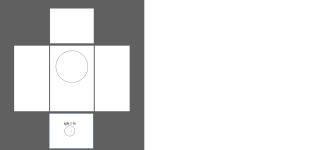Can someone please explain the relation between box volume to its over-all quality? more liter meaning the ability to play lower frequency? or?
more liter meaning the ability to play lower frequency? or?
According to Weems:
A closed box can be too small, but it can also be too big for optimum performance.
A large box might produce a weak bass response due to overdamping.
Very true but I guess we are making our friend rlojk's life complicated.
He joined 2 days ago with a single problem to solve, maybe best would be a "paint by the numbers" solution.
Such as Richard Ellis's best one or the "7 liter" closed box.
Given its single use service life I would suggest building the box gluing the walls together, too thin for screws or nails, and gluing the speaker to it's mounting hole using a silicone adhesive bead ring around, which will do double duty as sealant and vibration damper.
"Paint by the numbers" meaning: "build a x/y/z cm box, with a d diameter by l length tube inserted and glued in a 47 mm hole in one side (if the higher quality box is chosen)"
No more, no less.
Dear rlojk, please pick and build one of two.
He joined 2 days ago with a single problem to solve, maybe best would be a "paint by the numbers" solution.
Such as Richard Ellis's best one or the "7 liter" closed box.
Given its single use service life I would suggest building the box gluing the walls together, too thin for screws or nails, and gluing the speaker to it's mounting hole using a silicone adhesive bead ring around, which will do double duty as sealant and vibration damper.
"Paint by the numbers" meaning: "build a x/y/z cm box, with a d diameter by l length tube inserted and glued in a 47 mm hole in one side (if the higher quality box is chosen)"
No more, no less.
Dear rlojk, please pick and build one of two.
Such as Richard Ellis's best one or the "7 liter" closed box.
To summarise, Richard says 3.5 litres for the ported enclosure and 1.0 litre for the closed box.
Weems says "An optimum volume ported box will always be somewhat larger than the closed box for the same woofer".
Weems gives figures for one particular woofer that show the closed volume to be approximately one third of the ported volume
That would imply a closed box volume in the OP's case of 1.2 litre - in line with Richard's 1.0 litre.
So, if you want to keep it simple @rlogjk, I would plan for a 1.0 to 1.2 litre closed box and hope for the best!
P.S. Thanks for your support JMF!
Last edited:
This arrangement protects from dust in the long run, tooI saw an installation that had speaker boxes on the floor and they angled the speakers down at 45 degs. Imagine a rectangle but with a 45 deg cut at one end and then put the box down on its smallest face. The advantage is also that it gives good protection. Happy holidays.
View attachment 1251007
Terrible scribble, and the floor was very reflective.
What is this? silicone adhesive bead ringGiven its single use service life I would suggest building the box gluing the walls together, too thin for screws or nails, and gluing the speaker to it's mounting hole using a silicone adhesive bead ring around, which will do double duty as sealant and vibration damper.
Any link for example?
mounting the driver using its hole wouldn't be a good idea?
The gasket ring (the outer narrow ring that stands out proud from the frame of the driver) has an outside diameter of 75 mm.

A silicone adhesive is applied to the outside of the gasket ring and to the frame of the driver (the part with the four screw holes in it).
The driver is then inserted into the 75 mm cut-out in the box from behind. The silicone adhesive will both glue the driver in place and seal any gaps between the gasket and the cut-out. Lay the box with the speaker facing down overnight until the adhesive is fully cured.
Here are the details of the silicone sealant and adhesive that I use: https://www.halfords.com/motoring/p...nville-black-silicone-sealant-40g-173867.html

A silicone adhesive is applied to the outside of the gasket ring and to the frame of the driver (the part with the four screw holes in it).
The driver is then inserted into the 75 mm cut-out in the box from behind. The silicone adhesive will both glue the driver in place and seal any gaps between the gasket and the cut-out. Lay the box with the speaker facing down overnight until the adhesive is fully cured.
Here are the details of the silicone sealant and adhesive that I use: https://www.halfords.com/motoring/p...nville-black-silicone-sealant-40g-173867.html
Last edited:
Fully agree, but I was suggesting an even simpler solution: placing cabinet facing up and mounting speaker from the front, to avoid needing a removable back.
rlojk will probably need to buy a larger silicone sealant and application "pistol" to build the cabinet too.
Built with adhesive beads along joints as if he were building a glass fish tank.
Think Silastic or any generic clone:
https://www.insider.com/guides/home/how-to-use-a-caulk-gun
Of course, building out of precut wood is much easier/safer than using glass.
rlojk will probably need to buy a larger silicone sealant and application "pistol" to build the cabinet too.
Built with adhesive beads along joints as if he were building a glass fish tank.
Think Silastic or any generic clone:
https://www.insider.com/guides/home/how-to-use-a-caulk-gun
Of course, building out of precut wood is much easier/safer than using glass.
Correct me if I wrong but what I understood from the comments here is that the only way to mount this driver is from the back. it won't be possible to insert the driver from the outside of the box through the mounting hole right?Fully agree, but I was suggesting an even simpler solution: placing cabinet facing up and mounting speaker from the front, to avoid needing a removable back.
In that case I could just use 5M screw to mount the driver through the mounting holes (?)I am suggesting you insert it from the front.
I was suggesting an even simpler solution: placing cabinet facing up and mounting speaker from the front
The design of the driver doesn't lend itself to front mounting. Note the "lip" which is visible in this image that prevents flush mounting.
Correct me if I wrong but what I understood from the comments here is that the only way to mount this driver is from the back.
I am in agreement with your statement.
Addressing both doubts 🙂
I suggest:
1) cutting a 72.5 mm hole on baffle front.
2) if you put it face up on a table and place speaker there, it will NOT fall through the hole (look at speaker dimensions) but stay there, held by narrow edge all around.
Round part of speaker frame is 78mm diameter.
3) once you checked it fits, pull it, place an even silicone bead/ring around, then replace on baffle.
Thick and elastic (once cured) silicone will both glue it there and seal it.
4) mounting "ears" will NOT sit flush with baffle front but a couple mm away ... who cares?
5) no screws needed.
In any case I would not trust them much when screwed to 3 mm thin plywood/MDF
6) please check 70 mm magnet does indeed fit through 72.5 mm hole
This compact cabinet is doable.

I suggest:
1) cutting a 72.5 mm hole on baffle front.
2) if you put it face up on a table and place speaker there, it will NOT fall through the hole (look at speaker dimensions) but stay there, held by narrow edge all around.
Round part of speaker frame is 78mm diameter.
3) once you checked it fits, pull it, place an even silicone bead/ring around, then replace on baffle.
Thick and elastic (once cured) silicone will both glue it there and seal it.
4) mounting "ears" will NOT sit flush with baffle front but a couple mm away ... who cares?
5) no screws needed.
In any case I would not trust them much when screwed to 3 mm thin plywood/MDF
6) please check 70 mm magnet does indeed fit through 72.5 mm hole
This compact cabinet is doable.
mounting "ears" will NOT sit flush with baffle front but a couple mm away ... who cares?
Well, I did actually! 😀
@JMFahey
Perhaps you would be so kind as to check out rlogjk's parallel thread regarding suitable amplifier boards for use with this project:
https://www.diyaudio.com/community/threads/amplifiers-for-8-8ohm-speaker.406934/#post-7545873
Perhaps you would be so kind as to check out rlogjk's parallel thread regarding suitable amplifier boards for use with this project:
https://www.diyaudio.com/community/threads/amplifiers-for-8-8ohm-speaker.406934/#post-7545873
I'm sorry to ask again but I'm not sure I got it 100%.A silicone adhesive is applied to the outside of the gasket ring and to the frame of the driver (the part with the four screw holes in it).
The silicone should be on the blue ring? the pink or the green?
- Home
- Loudspeakers
- Full Range
- building boxes for speakers

